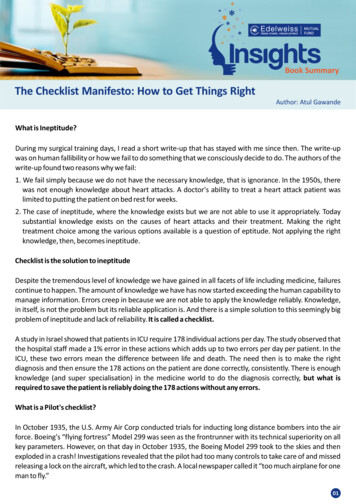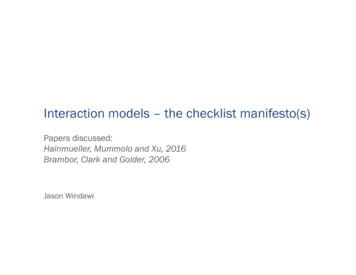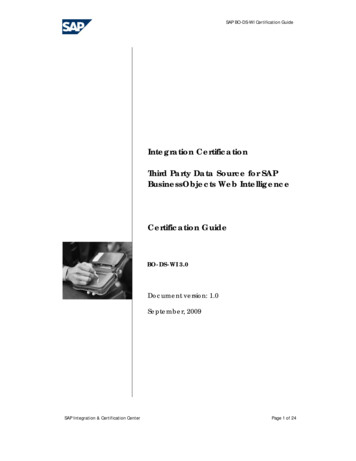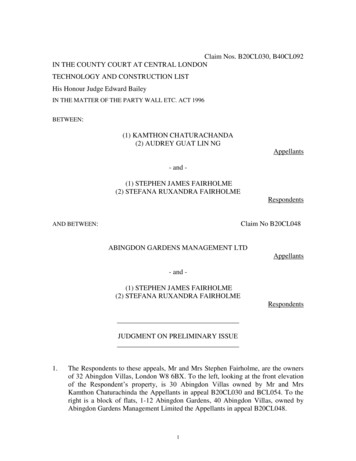
Transcription
Karl Marx and Frederick EngelsManifesto of theCommunist Partyand its genesisPublished by the Marxists Internet Archive
Written: Late 1847;First Published: February 1848.Marxists Internet ArchiveP.O. Box 1541; Pacifica, CA 94044; USA.CC-SA (Creative Commons Attribution-Share Alike 3.0)2010 by Marxists Internet ArchivePrinted by Bookmasters, Inc., Ohio.Edited by Andy Blunden, Proofed and corrected by Mike Bessler.Distributed exclusively by Erythrós Press and Media.Karl Marx (1818-1883) and Frederick Engels (1820-1895)1. Communism, 2. PoliticsISBN: 978-0-9805428-2-0
Table of ContentsEditorial Introduction . 1Preface to 1872 German Edition . 7Preface to 1882 Russian Edition . 9Preface to 1883 German Edition . 11Preface to 1888 English Edition . 13Preface to 1890 German Edition . 19Preface to 1892 Polish Edition . 23Preface to 1893 Italian Edition . 25Manifesto of the Communist Party . 27I. Bourgeois and Proletarians . 28II. Proletarians and Communists. 41III. Socialist and Communist Literature . 511. Reactionary Socialism . 512. Conservative or Bourgeois Socialism . 563. Critical-Utopian Socialism and Communism. 58IV. Position of the Communists in Relation to the Various ExistingOpposition Parties . 62Letter from Engels to Marx, 24 November 1847 . 65The Principles of Communism (October 1847) . 66Demands of the Communist Party in Germany (March 1848) . 89The Paris Commune. Address to the International Workingmen’sAssociation (May 1871). 93Glossary of Names . 109
Editorial IntroductionThe ―Manifesto of the Communist Party‖ was written by Marx andEngels as the program of the Communist League1 on the direction of itsSecond Congress (London, November 29-December 8, 1847), whichmarked a victory, line during the discussion of the programme questions,for those who saw the proletariat as the leading force for Communism.While Congress was still in preparation, Marx and Engels arrived at theconclusion that the final program document should be in the form of aParty manifesto (see Engels’ letter to Marx of November 23-24, 1847).The catechism form, usual for the secret societies of the time, andreflected in the earlier ―Draft of a Communist Confession of Faith‖ andthe ―Principles of Communism,‖ was not suitable to express and outlinethe broad revolutionary movement which was emerging. Acomprehensive formulation of the aims and historic tasks of the labourmovement was required. The ―Demands of the Communist Party inGermany,‖ on the other hand, issued by Marx soon after publication ofthe Manifesto, addressed the immediate demands of the movement inGermany, and contrasts with the Manifesto which continues to express themovement and aspirations of the working class to this day.Marx and Engels began working together on the Manifesto while theywere still in London immediately after the congress, and continued untilabout December 13 when Marx returned to Brussels. They resumed theirwork together when Engels arrived there on December 17. After Engels’departure for Paris at the end of December and up to his return onJanuary 31, Marx worked on the Manifesto alone.Hurried by the Central Authority of the Communist League whichprovided him with certain documents (e.g., addresses of the People’sChamber of the League of the Just of November 1846 and February1847, and, apparently, documents of the First Congress of theCommunist League pertaining to the discussion of the Party programme),Marx worked intensively on the Manifesto through almost the whole ofJanuary 1848. At the end of January, the manuscript was sent on toLondon to be printed in the German Workers’ Educational Society’sprint shop owned by a German emigrant J. E. Burghard, a member of theCommunist League.Marxists Internet Archive
2Genesis of the Communist ManifestoThe Manifesto came off the press at the end of February 1848. OnFebruary 29, the Educational Society decided to cover all the printingexpenses.The first edition of the Manifesto was a 23-page pamphlet in a dark greencover. In April-May 1848 another edition was put out. The text took up30 pages, some misprints of the first edition were corrected, and thepunctuation improved. Subsequently this text was used by Marx andEngels as a basis for later authorised editions. Between March and July1848 the Manifesto was printed in the Deutsche Londoner Zeitung, ademocratic newspaper of the German emigrants. Already that same yearnumerous efforts were made to publish the Manifesto in other Europeanlanguages. A Danish, a Polish (in Paris) and a Swedish (under the title:―The Voice of Communism. Declaration of the Communist Party‖)editions appeared in 1848. The translations into French, Italian andSpanish made at that time remained unpublished. In April 1848, Engels,then in Barmen, was translating the Manifesto into English, but hemanaged to translate only half of it, and the first English translation,made by Helen Macfarlane, was not published until two years later,between June and November 1850, in the Chartist 2 journal The RedRepublican. Its editor, Julian Harney, named the authors for the first timein the introduction to this publication. All earlier and many subsequenteditions of the Manifesto had been anonymous.The growing emancipation struggle of the proletariat in the ’60s and ’70sof the 19th century led to new editions of the Manifesto. The year 1872saw a new German edition with minor corrections and a preface by Marxand Engels where they drew some conclusions from the experience ofthe Paris Commune 3 of 1871. This and subsequent German editions(1883 and 1890) were entitled the Communist Manifesto. In 1872 theManifesto was first published in America in Woodhull & Claflin’s Weekly.The first Russian edition of the Manifesto, translated by Mikhail Bakunin,with some inaccuracies, appeared in Geneva in 1869. The faults of thisedition were removed in the 1882 edition (translation by GeorgiPlekhanov), for which Marx and Engels, who attributed great significanceto the dissemination of Marxism in Russia, had written a special preface.After Marx’s death, the Manifesto ran into several editions. Engels readthrough them all, wrote prefaces for the 1883 German edition and for the1888 English edition in Samuel Moore’s translation, which he also editedand supplied with notes. This edition served as a basis for manyMarxists Internet Archive
Introduction3subsequent editions of the Manifesto in English – in Britain, the UnitedStates and the USSR. In 1890, Engels prepared a further German edition,wrote a new preface to it, and added a number of notes. In 1885, thenewspaper Le Socialiste published the French translation of the Manifestomade by Marx’s daughter Laura Lafargue and read by Engels. He alsowrote prefaces to the 1892 Polish and 1893 Italian editions.***The very first version of the Manifesto was the ―Communist Confession ofFaith,‖ which was the draft programme discussed at the First Congress ofthe Communist League in London on June 2-9, 1847.The Congress was a final stage in the reorganisation of the League of theJust – an organisation of German workers and craftsmen. The Leaguewas founded in Paris in 1836-37 and soon acquired an internationalcharacter, with followers in Germany, France, Switzerland, Britain andSweden. Marx and Engels were working to promote the ideological andorganisational unity of socialists and revolutionary-minded workers, andapproached the leaders of the League (Karl Schapper, Joseph Moll,Heinrich Bauer) in London to ask for their help in reorganising theLeague and drafting its new programme. When Marx and Engels wereconvinced that the leaders of the League of the Just were ready to acceptthe principles of scientific communism as its programme they acceptedan offer to join the League which was made to them late in January 1847.Engels’ active participation in the work of the Congress (Marx wasunable to go to London for financial reasons) affected the course and theresults of its proceedings. The League was renamed the CommunistLeague, and the old motto of the League of the Just, ―All men arebrothers,‖ was replaced by a new, Marxist one: ―Working Men of AllCountries, Unite!‖ The draft programme and the draft Rules of theLeague were approved at the last sitting on June 9, 1847.The Draft takes the form of a series of questions and answers, just likeany of the catechisms which were traditional for secret societies of earlymodern times. However, the programme testifies to Engels’ influence onthe discussion at the Congress, for the answers to most of the 22questions are Marxist, despite the fact that the members of the Leaguewere still predominantly under the sway of utopian ideas, as was reflectedin the formulation of the first 6 questions and answers.After the First Congress of the Communist League, the ―Draft of aCommunist Confession of Faith‖ was sent, together with the draft Rules,Marxists Internet Archive
4Genesis of the Communist Manifestoto the various communities of the League for discussion, the results ofwhich were to be taken into account at the time of the final approval ofthe programme and the Rules at the Second Congress. When working onthe ―Principles of Communism,‖ in late October 1847, Engels madedirect use of the ―Confession of Faith,‖ as is reflected in the manycoincidences of the texts, and also from references in the Principles to theearlier document where Engels had decided to leave some of theformulations just as they were.The text of ―The Principles of Communism‖ is included in this edition.In the letter to Marx in late November 1847, also included below, Engelssuggested to Marx the need to adopt the form of a manifesto rather thana catechism. It can be seen however that the Principles remains in the formof a catechism. It was not just a question of including some historicalnarrative, but of the need of the Manifesto to both speak to and give voiceto the international proletariat. The form of catechism was tied to thepractice of swearing in new members with an oath of loyalty and secrecy,something quite unsuitable for an emancipatory mass movement.On the other hand, the ―Demands of the Communist Party in Germany‖is included to place the publication of the Manifesto in the context of themass movement in Germany at the time, the movement whoseimmediate demands are reflected by Marx in this pamphlet. Clearly theaims of the Manifesto were more far-reaching than the movement inGermany at the time, and unlike the ―Demands,‖ was to outlive theimmediate conditions in Germany.The ―Third Address to the International Workingmen’s Association‖ isincluded because in this speech Marx examines the movement of theworking class manifested in the Paris Commune, and his observationshere mark the only revisions to his social and historical vision madeduring his lifetime as a result of the development of the working classmovement itself, clarifying some points and making others more concrete,particularly in connection with the state.The Communist League — established at a congress of the League of the Justin London on June 2, 1847. Engels was in attendance as the delegate for theLeague’s Paris communities. The Congress inaugurated the CommunistLeague as the first international proletarian organisation. The trial of theleaders of the German communists at Cologne in the wake of the defeat of1Marxists Internet Archive
Introduction5the 1848 Revolution, brought the movement to an end and the League wasdissolved.2 The Chartists — The first mass revolutionary movement of the Britishworking class. The Chartists mobilised millions in demonstrations andmarches and petitions to Parliament demanding universal male suffrage andother democratic measures. Although their petitions were all rejected, theiraims were all eventually achieved, and between 1842 and 1847 a number ofeconomic measures such as the Ten-Hours Bill were legislated to appease theworkers’ movement.3 The Paris Commune — In March 1871, under siege by the Prussian armyfollowing the defeat of a French military adventure, the workers of Paristook state power and set out to implement a socialist program. They werebrutally crushed after only 2 months, never having been able to break out ofconfines of Paris. Marx saw the Commune as the first great revolutionarymovement of the European working class since the crushing of therevolutions of 1848 and he closely followed all its actions and proposals,particularly in relation to the problems of the seizure of power andsuppression of the bourgeois counter-revolution, and the form of state thatthe working class would itself seek to establish.Marxists Internet Archive
Preface to 1872 German EditionThe Communist League, an international association of workers, whichcould of course be only a secret one, under conditions obtaining at thetime, commissioned us, the undersigned, at the Congress held in Londonin November 1847, to write for publication a detailed theoretical andpractical programme for the Party. Such was the origin of the followingManifesto, the manuscript of which travelled to London to be printed afew weeks before the February [French] Revolution [in 1848]. Firstpublished in German, it has been republished in that language in at leasttwelve different editions in Germany, England, and America. It waspublished in English for the first time in 1850 in the Red Republican,London, translated by Miss Helen Macfarlane, and in 1871 in at leastthree different translations in America. The French version first appearedin Paris shortly before the June insurrection of 1848, and recently in LeSocialiste of New York. A new translation is in the course of preparation.A Polish version appeared in London shortly after it was first publishedin Germany. A Russian translation was published in Geneva in thesixties4. Into Danish, too, it was translated shortly after its appearance.However much that state of things may have altered during the lasttwenty-five years, the general principles laid down in the Manifesto are,on the whole, as correct today as ever. Here and there, some detail mightbe improved. The practical application of the principles will depend, asthe Manifesto itself states, everywhere and at all times, on the historicalconditions for the time being existing, and, for that reason, no specialstress is laid on the revolutionary measures proposed at the end ofSection II. That passage would, in many respects, be very differentlyworded today. In view of the gigantic strides of Modern Industry since1848, and of the accompanying improved and extended organisation ofthe working class, in view of the practical experience gained, first in theFebruary Revolution, and then, still more, in the Paris Commune, wherethe proletariat for the first time held political power for two wholemonths, this programme has in some details been antiquated. One thingespecially was proved by the Commune, viz., that ―the working classcannot simply lay hold of the ready-made state machinery, and wield itfor its own purposes.‖ (See p. 93ff, Address to the InternationalWorkingmen’s Association, May 1871, where this point is furtherMarxists Internet Archive
8Genesis of the Communist Manifestodeveloped.) Further, it is self-evident that the criticism of socialistliterature is deficient in relation to the present time, because it comesdown only to 1847; also that the remarks on the relation of theCommunists to the various opposition parties (Section IV), although, inprinciple still correct, yet in practice are antiquated, because the politicalsituation has been entirely changed, and the progress of history has sweptfrom off the earth the greater portion of the political parties thereenumerated.But then, the Manifesto has become a historical document which wehave no longer any right to alter. A subsequent edition may perhapsappear with an introduction bridging the gap from 1847 to the presentday; but this reprint was too unexpected to leave us time for that.Karl Marx & Frederick EngelsJune 24, 1872, LondonThe first Russian translation of the Manifesto of the Communist Party wasmade by Mikhail Bakunin, who despite being one of Marx and Engels’ mostpronounced opponents in the working class movement, saw the greatrevolutionary importance contained within the Manifesto. Published inGeneva in 1869 (printing it in Russia was impossible due to statecensorship), Bakunin’s translation was not completely accurate, and wasreplaced by Georgi Plekhanov’s translation in 1882, for which both Marxand Engels wrote a preface.4Marxists Internet Archive
Preface to 1882 Russian EditionThe first Russian edition of the Manifesto of the Communist Party,translated by Bakunin, was published early in the ’sixties by the printingoffice of the Kolokol [a reference to the Free Russian Printing House].Then the West could see in it (the Russian edition of the Manifesto) onlya literary curiosity. Such a view would be impossible today.What a limited field the proletarian movement occupied at that time(December 1847) is most clearly shown by the last section: the positionof the Communists in relation to the various opposition parties in variouscountries. Precisely Russia and the United States are missing here. It wasthe time when Russia constituted the last great reserve of all Europeanreaction, when the United States absorbed the surplus proletarian forcesof Europe through immigration. Both countries provided Europe withraw materials and were at the same time markets for the sale of itsindustrial products. Both were, therefore, in one way of another, pillarsof the existing European system.How very different today. Precisely European immigration fitted NorthAmerican for a gigantic agricultural production, whose competition isshaking the very foundations of European landed property – large andsmall. At the same time, it enabled the United States to exploit itstremendous industrial resources with an energy and on a scale that mustshortly break the industrial monopoly of Western Europe, and especiallyof England, existing up to now. Both circumstances react in arevolutionary manner upon America itself. Step by step, the small andmiddle land ownership of the farmers, the basis of the whole politicalconstitution, is succumbing to the competition of giant farms; at thesame time, a mass industrial proletariat and a fabulous concentration ofcapital funds are developing for the first time in the industrial regions.And now Russia! During the Revolution of 1848-9 5 , not only theEuropean princes, but the European bourgeois as well, found their onlysalvation from the proletariat just beginning to awaken in Russianintervention. The Tsar was proclaimed the chief of European reaction.Today, he is a prisoner of war of the revolution in Gatchina6, and Russiaforms the vanguard of revolutionary action in Europe.The Communist Manifesto had, as its object, the proclamation of theinevitable impending dissolution of modern bourgeois property. But inMarxists Internet Archive
10Genesis of the Communist ManifestoRussia we find, face-to-face with the rapidly flowering capitalist swindleand bourgeois property, just beginning to develop, more than half theland owned in common by the peasants. Now the question is: can theRussian obshchina7, though greatly undermined, yet a form of primevalcommon ownership of land, pass directly to the higher form ofCommunist common ownership? Or, on the contrary, must it first passthrough the same process of dissolution such as constitutes the historicalevolution of the West?The only answer to that possible today is this: If the Russian Revolutionbecomes the signal for a proletarian revolution in the West, so that bothcomplement each other, the present Russian common ownership of landmay serve as the starting point for a communist development.Karl Marx & Frederick EngelsJanuary 21, 1882, LondonThe Revolution of 1848 — In February 1848, a spontaneous uprising of theFrench proletariat brought down the reactionary ―July Monarchy‖ andworkers’ representatives entered into a coalition with bourgeois politicians.The victory of the workers triggered a wave of revolutions across the wholeof Europe, destroying the ancien régime once for all. But the French workerssoon came into conflict with the new government. A massive proletarianuprising in Paris was crushed with more than 50,000 workers killed. Thecounter-revolutionary wave also spread across Europe and by June 1849reaction had triumphed. Nonetheless, the political terrain of Europe hadchanged forever; the European proletariat was now committed to a socialistprogram and was a political force in its own right.6 Gatchina — A reference to the events that occurred in Russia after theMarch, 1, 1881, assassination of Emperor Alexander II by Narodnaya Volyamembers. Alexander III, his successor, was staying in Gatchina for fear offurther terrorism.7 Obshchina — Self-governing, cooperative Russian peasant communitiesdating back to the early 16th century, before feudalism took root in Russia.5Marxists Internet Archive
Preface to 1883 German EditionThe preface to the present edition I must, alas, sign alone. Marx, the manto whom the whole working class of Europe and America owes morethan to any one else – rests at Highgate Cemetery and over his grave thefirst grass is already growing. Since his death [March 14, 1883], there canbe even less thought of revising or supplementing the Manifesto. But Iconsider it all the more necessary again to state the following expressly:The basic thought running through the Manifesto – that economicproduction, and the structure of society of every historical epochnecessarily arising therefrom, constitute the foundation for the politicaland intellectual history of that epoch; that consequently (ever since thedissolution of the primaeval communal ownership of land) all history hasbeen a history of class struggles, of struggles between exploited andexploiting, between dominated and dominating classes at various stagesof social evolution; that this struggle, however, has now reached a stagewhere the exploited and oppressed class (the proletariat) can no longeremancipate itself from the class which exploits and oppresses it (thebourgeoisie), without at the same time forever freeing the whole ofsociety from exploitation, oppression, class struggles – this basic thoughtbelongs solely and exclusively to Marx.*I have already stated this many times; but precisely now is it necessarythat it also stand in front of the Manifesto itself.Frederick EngelsJune 28, 1883, London―This proposition,‖ I wrote in the preface to the English translation, ―which, in myopinion, is destined to do for history what Darwin’s theory has done for biology, we bothof us, had been gradually approaching for some years before 1845. How far I hadindependently progressed towards it is best shown by my Conditions of the WorkingClass in England. But when I again met Marx at Brussels, in spring 1845, he had it alreadyworked out and put it before me in terms almost as clear as those in which I have stated ithere.‖ [Note by Engels to the German edition of 1890]*Marxists Internet Archive
Preface to 1888 English EditionThe Manifesto was published as the platform of the Communist League,a working men’s association, first exclusively German, later oninternational, and under the political conditions of the Continent before1848, unavoidably a secret society. At a Congress of the League, held inNovember 1847, Marx and Engels were commissioned to prepare acomplete theoretical and practical party programme. Drawn up inGerman, in January 1848, the manuscript was sent to the printer inLondon a few weeks before the French Revolution of February 24. AFrench translation was brought out in Paris shortly before theinsurrection of June 1848. The first English translation, by Miss HelenMacfarlane, appeared in George Julian Harney’s Red Republican, London,1850. A Danish and a Polish edition had also been published.The defeat of the Parisian insurrection of June 1848 – the first greatbattle between proletariat and bourgeoisie – drove again into thebackground, for a time, the social and political aspirations of theEuropean working class. Thenceforth, the struggle for supremacy was,again, as it had been before the Revolution of February, solely betweendifferent sections of the propertied class; the working class was reducedto a fight for political elbow-room, and to the position of extreme wingof the middle-class Radicals. Wherever independent proletarianmovements continued to show signs of life, they were ruthlessly hunteddown. Thus the Prussian police hunted out the Central Board of theCommunist League, then located in Cologne. The members were arrestedand, after eighteen months’ imprisonment, they were tried in October1852. This celebrated ―Cologne Communist Trial‖ lasted from October 4till November 12; seven of the prisoners were sentenced to terms ofimprisonment in a fortress, varying from three to six years. Immediatelyafter the sentence, the League was formally dissolved by the remainingmembers. As to the Manifesto, it seemed henceforth doomed tooblivion.When the European workers had recovered sufficient strength foranother attack on the ruling classes, the International Working Men’sAssociation8 sprang up. But this association, formed with the express aimof welding into one body the whole militant proletariat of Europe andMarxists Internet Archive
14Genesis of the Communist ManifestoAmerica, could not at once proclaim the principles laid down in theManifesto. The International was bound to have a programme broadenough to be acceptable to the English trade unions, to the followers ofProudhon in France, Belgium, Italy, and Spain, and to the Lassalleans inGermany.*Marx, who drew up this programme to the satisfaction of all parties,entirely trusted to the intellectual development of the working class,which was sure to result from combined action and mutual discussion.The very events and vicissitudes in the struggle against capital, the defeatseven more than the victories, could not help bringing home to men’sminds the insufficiency of their various favorite nostrums, and preparingthe way for a more complete insight into the true conditions for workingclass emancipation. And Marx was right. The International, on itsbreaking in 1874, left the workers quite different men from what it foundthem in 1864. Proudhonism in France, Lassalleanism in Germany, weredying out, and even the conservative English trade unions, though mostof them had long since severed their connection with the International,were gradually advancing towards that point at which, last year atSwansea, their president [W. Bevan] could say in their name:―Continental socialism has lost its terror for us.‖ In fact, the principles ofthe Manifesto had made considerable headway among the working menof all countries.The Manifesto itself came thus to the front again. Since 1850, theGerman text had been reprinted several times in Switzerland, England,and America. In 1872, it was translated into English in New York, wherethe translation was published in Woodhull and Claflin’s Weekly. From thisEnglish version, a French one was made in Le Socialiste of New York.Since then, at least two more English translations, more or less mutilated,have been brought out in America, and one of them has been reprintedin England. The first Russian translation, made by Bakunin, waspublished at Herzen’s Kolokol office in Geneva, about 1863; a secondone, by the heroic Vera Zasulich, also in Geneva, in 1882. A new Danishedition is to be found in Socialdemokratisk Bibliothek, Copenhagen, 1885; afresh French translation in Le Socialiste, Paris, 1886. From this latter, aLassalle personally, to us, always acknowledged himself to be a disciple of Marx, and, assuch, stood on the ground of the Manifesto. But in his first public agitation, 1862-1864, hedid not go beyond demanding co-operative workshops supported by state credit. [Noteby Engels.]*Marxists Internet Archive
1888 Preface15Spanish version was prepared and published in Madrid, 1886. TheGerman reprints are not to be counted; there have been twelve altogetherat the least. An Armenian translation, which was to be published inConstantinople some months ago, did not see the light, I am told,because the publisher was afraid of bringing out a book with the name ofMarx on it, while the translator declined to call it his own production. Offurther translations into other languages I have heard but had not seen.Thus the history of the Manifesto reflects the history of the modernworking-class movement; at present, it is doubtless the most wide s
2 Genesis of the Communist Manifesto Marxists Internet Archive The Manifesto came off the press at the end of February 1848. On February 29, the Educational Society decided to cover all the printing expenses. The first edition of the Manifesto was a 23-page pamphlet in a dark gr











